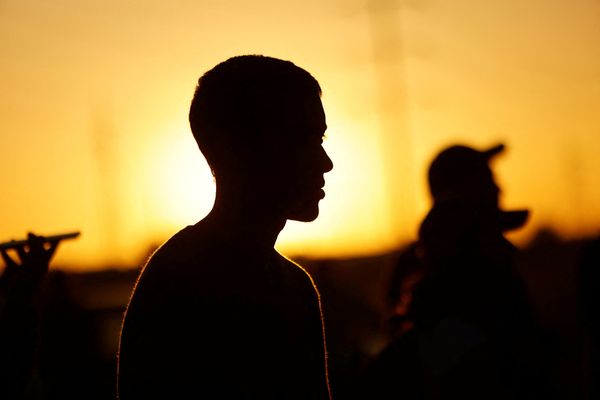DENVER — Dust and smoke blowing in from fires, dry land and construction this spring periodically have turned Colorado’s blue skies red, and air quality experts anticipate more crazy haze in the future as wind scours particles from the arid Southwest.
Nose-level concentrations of tiny, lung-lodging particles hit 24-hour averages as high as 207 micrograms per cubic meter of air Monday afternoon in Colorado Springs. That’s 33% higher than a federal health threshold of 155 micrograms. The level spiked briefly to 422, at a state monitor near Colorado College before sunrise, then quickly dissipated — a challenge for state officials tasked with keeping public health warnings current.
Multiple sources mix, state and federal meteorologists said, as high winds carry roiling clouds. Wildfire smoke from New Mexico, where fires have burned more than 250,000 acres, has risen into high-level air currents. Dust from the bone-dry Four Corners region and other landscapes reached Colorado’s urban Front Range. And exposed grit from the common construction sites, where topsoil has been scraped away, intensifies the wind-churned brew.
Visibility at times decreased to less than five miles, a measure state health officials say residents can use to determine whether air is unhealthy to inhale. From metro Denver south to Trinidad this week, residents periodically could not see the mountains.
Expect more of the same with forecasts calling for higher-than-average heat, red-flag fire risks, and no rain through this week.
And expect more in the future if current climate trends continue, said Jeff Derry, director of the Center for Snow and Avalanche Studies, who since 2002 has been monitoring National Oceanic and Atmospheric Administration satellite imagery and dust on mountain snowpack.
“Drought and heat means we’ll probably see more fires. That means more smoke. For dust, with stressed vegetation and less water on landscapes in dust source regions of the Southwest, we should probably expect more dust,” Derry said.
“All the science is pointing towards that. It means decreased air quality. And it means more dust in the mountains on snowpack,” he said. “It is going to melt the snow faster. An earlier snow melt typically means less water later in the summer.”
National Weather Service meteorologists monitoring satellite images have tracked multiple wind-driven plumes that spread across Colorado.
Significant smoke from the New Mexico wildfires that have forced evacuations “isn’t necessarily something people would smell, but it looks hazy” along the Front Range, NWS meteorologist Kari Bowen said. “And then there’s some dust over northwestern New Mexico. And localized dust can lift up. If people live near construction sites, and it’s a little windy, they could see dust that way,” Bowen said. “The landscape can get very dry, which creates the ability at a certain wind speed to lift more of that dirt and carry it as it dries out.”
State health authorities on Monday and Tuesday issued an unhealthy air alert for sensitive people (children, the elderly and infirm) in the Colorado Springs area. Metro Denver air quality deteriorated to “moderate” unhealthy conditions. What residents face varies by location and fluctuates.
“The best thing to do is always keep apprised of air quality in your location,” said Dan Welsh, air quality meteorologist for the Colorado Department of Public Health and the Environment, who characterized the most recent dust-and-smoke storms that started on Sunday as “notable in the intensity for a short duration.”
Colorado residents can check government-run websites (colorado.gov/air quality and airnow.gov) and should “take any health precautions you feel are necessary,” Welsh said.
Medical experts warn of potential “compounding effects” as particulates mix with the ground-level ozone pollution, for which Colorado has been deemed a “severe” violator of federal health standards. Wind also spreads pollen that afflicts residents with allergies.
“You begin to get a lot of chemical reactions,” said Dr. Mark Ereth, an emeritus professor at the Mayo Clinic who serves on boards of air filtration companies and helps guide the American Society of Heating, Refrigerating and Air-Conditioning Engineers.
“We need to look at the concept of our lifetime exposure,” Ereth said.
“The particulates cross into your bloodstream. They’re taken up by your organs. That’s where they introduce inflammation. The inflammation is a source of hardening of the arteries and cerebral vascular diseases,” he said. “We’ll have to modify our indoor and outdoor lifestyles based on air quality. ... There’s no question that breathing cleaner air will extend your life.”
The first step to reducing exposure during dust storms is reducing physical exertion and heading indoors, health officials say. Filtering indoor air using air conditioning and other devices can create safe spaces, especially for sleeping.
Face masks that residents amassed during the COVID-19 pandemic also can be used to reduce the amount of particles and pollen you inhale.
“Stay aware of the air quality conditions in your area,” Welsh said. “Know what prevention measures to take to protect yourself.”
———







